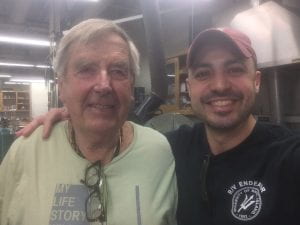We are about to embark on the first winter cruise of our NSF sponsored marine aerosol seasonal study to the Bermuda Atlantic Time-series Study (BATS) site, which is located approximately 60 miles southeast of Bermuda.

Why are we going to sea? Previously, our team used radiocarbon (14C) dating to show that very old organic matter in seawater is thrown into the atmosphere as tiny particles (aerosol) when air bubbles burst at the sea surface. On average, our measurements showed that the organic matter on these particles was ~1,370 years old (Beaupre et al., 2019), suggesting that a significant fraction of old organic matter is removed from the ocean each year by bubbles generated from breaking waves. In general, the rates at which substances react and move around the Earth control the chemical composition of the land, air, and sea; and it is the chemical composition of our land, air, and sea that makes Earth habitable given its size and position in our solar system. Therefore, knowing how much and how quickly this process influences our planet’s chemical composition is important.
However, our observations were from aerosol generated in one area of the ocean, during one season of one year: the seas between Bermuda and New England during autumn of 2016. In other words, we discovered that very old organic matter can leave the ocean with aerosol, but we don’t know if it leaves the ocean in the same way all the time. For example, spring and summer blooms produce new organic matter that mixes with older organic matter already in the ocean. This natural seasonal variability in both the composition and average age of molecules in the sea surface could influence the proportion of old molecules that are removed by aerosol. Therefore, we are now going to sea in both summer and winter to measure how seasonal changes in seawater composition affect marine aerosol composition.
One of the best places in the world to perform our study is the BATS site. It has a monthly record of physical, chemical, and biological observations since 1988! It is an open ocean site that is, in many ways, representative of most of the world ocean. And yet, it is still accessible due to its close proximity to Bermuda, the resources available at Bermuda Institute of Ocean Sciences (BIOS), and the dependable fleet of UNOLS research vessels. We are taking advantage of this remarkable site to help us put our comparatively short study of seasonal variability (2 years) into broader context.

Since August 2020, we’ve been working around the clock washing bottles, shipping gear, holding Zoom meetings, and taking countless COVID tests. We had a successful summer cruise to BATS in July 2021 aboard the R/V Atlantic Explorer, and we’re ready for our first winter cruise aboard the R/V Endeavor. We have been successful at sea largely because we’re working with truly exceptional ship-ops teams from BIOS and the University of Rhode Island (URI). We can’t thank them enough for their competence, kindness, patience, and ability to safely take us to sea and bring us back home.

We had planned to load half of our gear aboard Endeavor on Jan 10, leave Rhode Island on Jan 11, and arrive in Bermuda on Jan 14. We then planned to spend 4 days installing a 20′ cargo container that holds a sea-going aerosol generating laboratory, and finally steam to BATS for 10 days of science.
The North Atlantic had other plans, as it often does in winter. Two back-to-back storms have been sweeping across the ocean with hurricane force winds, whipping up ramparts of “ship killing” waves between us and our destination that forced us to delay our departure by 8 days. We are now scheduled to depart Rhode Island on Wednesday, Jan 19, weather permitting…

Weather delays like this are boons and banes for oceanographers.
Yes, we are behind schedule and we haven’t even left the dock. A lot of good, hardworking people have to put in more overtime to keep the program moving safely ahead. There are flights to cancel, cranes to reschedule, and COVID tests to repeat. We’re losing more family time and accumulating more responsibilities. Our most precious possession is our time, and we can never get it back when it is taken from us.
However, at this same moment, our ship-board team has been given the gift of some much-needed and mostly distraction-free time to work together, to be creative, and to laugh together as old friends should. We are a pod of certifiably COVID-free colleagues during an unprecedented worldwide spike in cases. And our dock-side internet connection is strong enough for an occasional Zoom meeting with the people that we love–a luxury oceanographers usually don’t have while they are away. We have even had time to “leisurely” fasten our gear for a rough ride, to get more than 4 hours of sleep, and to finally post something on a long-neglected website!

Even though most places on a map of the Earth are easily recognizable and shockingly accessible, our delay humbly reminds us that this place we call home is a planet–a massive, powerful, and ever changing system of atoms that move and react. It is awesome, in the truest sense. And all of us are part of that planet (also in the truest sense). I am particularly humbled by the achievements of curiosity-driven people who, over generations, discovered how to turn rocks into rockets, observations into equations, and to develop the systems of satellites and models that tell us which way the atoms will move through our atmosphere and our ocean. Thank you for nurturing your curiosity. Thank you for giving us the weather forecasts that advised us to stay in port this week so that we can safely explore our planet next week. And thank you, curious reader, for visiting our site.
If all goes according to plan, you can follow our ship as it leaves Rhode Island on Wednesday at the EndeavorNow website.








